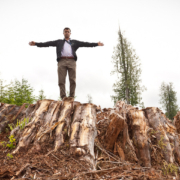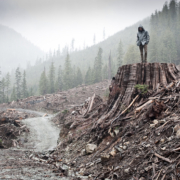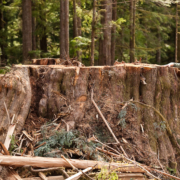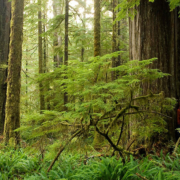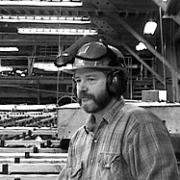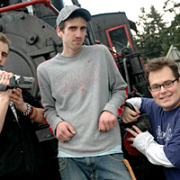Forestry Watchdog Concludes Strong Public Interest for Saving Ancient Forests and that BC Government can Readily Protect Avatar Grove
The Ancient Forest Alliance is encouraged by several conclusions from yesterday’s report by BC’s Forest Practices Board (FPB) about the Avatar Grove and a nearby clearcut of enormous stumps close to Port Renfrew on Vancouver Island [see photos in the next email – also video clips available by request for TV media]. Click here to see report The Forest Practices Board is a government-appointed, third party watchdog group on BC’s forestry practices.
The report was issued yesterday in regards to a private complaint from a BC resident (a University of Victoria Environment Studies professor) regarding two old-growth areas, one logged and one still standing, in the Gordon River Valley near Port Renfrew: an ancient stand of near-record size redcedars – now a clearcut of giant stumps (logged in early 2010) – and the nearby Avatar Grove, still standing for now but threatened with potential logging. Both areas were found and highlighted to the media in 2010 by the Ancient Forest Alliance.
“This report brings the welcome conclusions that there is ‘strong public interest’ in protecting our extremely rare, monumental stands of coastal ancient forests like the Avatar Grove, and that the BC government has the legal mechanisms to quickly protect them – if they have the political will,” stated TJ Watt, Ancient Forest Alliance photographer and explorer who stumbled across the Avatar Grove over a year ago. “Lets hope the BC government will listen to their own appointed watchdog.”
The logged stand of ancient western redcedars investigated by the FPB report was among the most exceptional groves of remaining giant trees in North America until it was cut down – with several tree specimens that were 13 to 15 feet in trunk diameter. The Avatar Grove is perhaps the most easily accessible, endangered stand of monumental ancient Douglas firs and redcedars (some with remarkably giant burls, see the incredible photogallery at: https://16.52.162.165/photos-media/ ) in BC. Both areas are featured in the Ancient Forest Alliance’s newest video clip (1 minute), “Canada’s Gnarliest Tree – Save the Avatar Grove” on Youtube, which has had almost 4000 viewers in just two weeks. See https://www.youtube.com/watch?v=l_uPkAWsvVw
The report of the Forest Practices Board which investigated concerns about the “special value of trees of exceptional size or form, age or historical significance” that can be from 500 to over 1,000 years old, states that, “Having withstood the ravages of time over many centuries, they can inspire awe and reverence, a sense of spirituality and connection to past events,” and there is “strong public interest in seeing more ancient trees and forest stands preserved to live out their natural lives and functions, and managed as a social, economic and ecological asset to the public and surrounding communities.”
The report notes that a miniscule fraction – just 1% – of the Gordon Valley region (“landcape unit”) consists of protected stands of exceptionally large, monumental old-growth trees over 400 years in age, which the complainant to the FPB termed “ancient forests” to distinguish them from regular old-growth forests. In addition, it notes that only 15.7% of the Gordon landscape unit is protected in Old-Growth Management Areas (OGMA’s).
The report also states in regards to the endangered Avatar Grove, 75% of which is open for logging (25% is protected within OGMA’s), that “current options to protect the unprotected part of the area include creation of a new park or other reserve, or expansion of the existing OGMAs” and that “If further protection is warranted for Avatar Grove, government has available policy and procedures to guide potential amendment of its land]use objective” to protect the area.
The Avatar Grove is the most easily accessible, monumental stand of endangered ancient redcedars and Douglas firs in a wilderness setting on southern Vancouver Island. It can be accessed not far past the end of a paved road, growing on relatively gentle terrain, only a 15 minute drive from Port Renfrew. Ancient Forest Alliance campaigner and photographer TJ Watt came across the Avatar Grove in December, 2009, while on an exploratory expedition in the Gordon River Valley. It is home to cougars, wolves, bears, elk, and deer. Support for protecting the Avatar Grove is extensive, and includes the Port Renfrew Chamber of Commerce, the Sooke Regional Tourism Association, and elected political representatives at all three jurisdictional levels, including federal Liberal MP Keith Martin, provincial NDP MLA John Horgan, and Regional Director Mike Hicks.
“If the Avatar Grove falls, Port Renfrew won’t get another chance like this again for many human lifetimes,” stated TJ Watt. “The protection of the Avatar Grove – should the BC Liberal government have the wisdom and foresight – could very well become the ‘breadbasket’ for a tourism dependent community like Port Renfrew. I think most businesses in the community recognize this.”
The Ancient Forest Alliance is working to end the logging of endangered old-growth forests in BC, to ensure the sustainable logging of second-growth forests which now comprise most of southern BC’s forest lands, and to end the export of raw logs to foreign mills.
Old-growth forests are important for endangered species, the climate, tourism, clean water, and many First Nations cultures.
“Our ancient forests are as much a part of BC’s heritage as the Canucks, whale-watching, and Stanley Park,” states Ken Wu, Ancient Forest Alliance executive director. “How many jurisdictions on Earth still have trees that grow as wide as living rooms and as tall as downtown skyscrapers? And how many still say it’s good to cut down them down? We now have a major second-growth alternative, so it’s nuts to keep logging towards the end of the old-growth resource at this stage in our history.”

